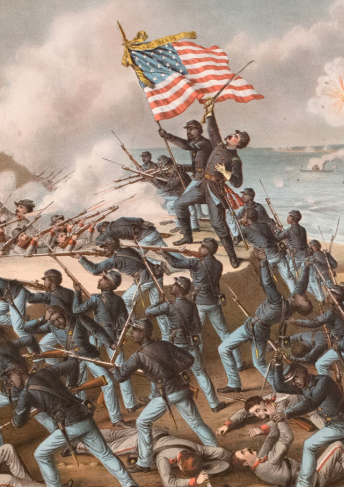Memoir of a soldier engaged in guerilla warfare in the Philippines.
np: c. 1902.
Price: $1,750.00
About the item
5-[67] manuscript pages on the rectos of unbound sheets. 8 x 5 inches. Lacking the first 4 leaves and an indeterminate number at end, several leaves quite worn, each crudely taped or pasted to modern paper, and then crudely cropped at the top edge without loss of text.
Item #311327
This account consists of pages five to sixty-seven of what appears to be a diary, or copied letters of an unnamed soldier in the 21st United States Infantry. The author, who may have been a corporal, remains unidentified by name. The account begins in August 1898 at Camp Hobson, Lithia Springs, GA; in September he is transferred to Plattsburgh, NY, rejoining the bulk of his regiment, which had suffered heavy losses in Cuba.
The Philippine-American war ran from February 1899 to July 1902, and was regarded as a continuation of a war for independence by the Philippines and as an insurrection by the United States of America. This account spans the duration of it, providing rich detail on topics ranging from food to the war-ravaged environment and American-Philippino interactions both on and off the battlefield.
An epic train ride across the country and then a boat from San Francisco brought the 21st US Infantry to Manila on 11 May 1899, in the fourth month of the conflict. The author mentions shipboard conditions, an engine breaking down, and comments "We caught 4 sharks in our trip. The largest was 12 feet long and took the whole crowd to land him aboard... the men used the bones for rings and pen holders and in fact every thing you could think."
Their first combat was the capture of an insurgent outpost at Guadaloupa Ridge on 9 June, 1899, where they "joined General Lauter's Flying Column ... [with] eight chinamen to carry our rations."
The description of this combat and its aftermath (pages 33-41) is the most dramatic passage in the memoir. The writer was sent with another soldier to gather up some supplies that had been left behind, but they were separated from the regiment with no food or water. They made a makeshift fort from some old haversacks and brush when they were unable to return to the trenches that night. The author describes scavenging after battle as follows: "About 10:00 oclock there was several chinamen came looking around and picking up what-ever they seen. They came to close to us to suit me and we shot 4 and the rest ran away."
Going out in search of water at about four in the morning, despite ongoing fire, the author found several dead and mortally wounded soldiers from a black regiment, including a graphic description of one man who had been shot at close range and had a hole the size of a fist in his belly and was covered in blood. Of the only survivor, the author says: "Found one poor cuss shot through the hip. He could not move. I gave him some hard tack and he gave me water, then I went back to our haversacks." Another disoriented soldier, whom the author names as H. McBain, was found wandering without most of his clothing, brandishing a bottle of wine and an axe.
After waiting until the 11th for a reclamation detail, the author and his companion crawled through the brush for a mile to San Peter McCarty and eventually rejoined their regiment at Los Penes, where their captain threatened to have them court-martialed for losing their haversacks.
Later while hospitalized, the author was befriended by Señora Edna Luna, cousin of an insurgent general, who took him out riding daily: "She was stuck on me, and that is no lie. I think I ought to go back and hook up with her, as she has all that is required. She is hansome & plenty of money" (page 45).
The author -- first too ill to be moved, then put in a wheel chair, and with trouble with his vision -- was transferred back to the States on 15 May 1900 (page 48), by way of Nagasaki (May 21, 1900) and Yokohama, arrived in San Francisco on June 9, 1900, then was sent to recover at Hot Springs, Arkansas, concluding in Vancouver Barracks, Washington circa July 1901.
Some of the pages are torn and some text is lost at the bottom edges due to wear, but the handwriting is clear and the voice of the author shines through. This narrative, though it took place before World War One, reads more akin to a Vietnam War narrative than a Civil War diary in tone and disregard for authority and the morality of war.


